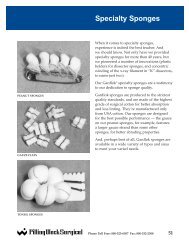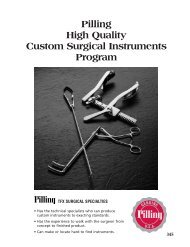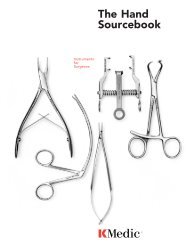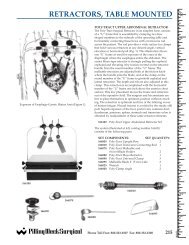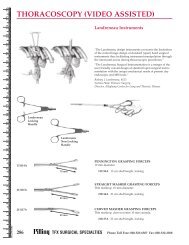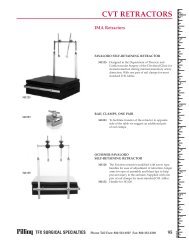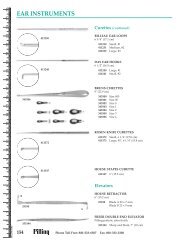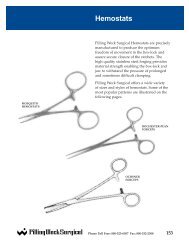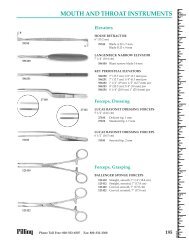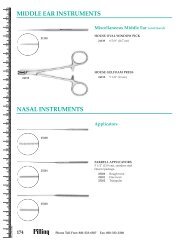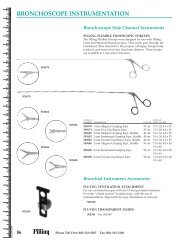391 surgical instrument troubleshooting
391 surgical instrument troubleshooting
391 surgical instrument troubleshooting
Create successful ePaper yourself
Turn your PDF publications into a flip-book with our unique Google optimized e-Paper software.
SURGICAL INSTRUMENT<br />
TROUBLESHOOTING<br />
Troubleshooting, otherwise referred to by some of<br />
us as fire fighting, hoping to lead to fire prevention<br />
in the care and handling of <strong>surgical</strong> <strong>instrument</strong>ation.<br />
The most common problems with <strong>instrument</strong>s<br />
are discoloration, pitting, staining, spotting or actual<br />
rusting. In the event of chrome <strong>instrument</strong>ation it<br />
is literally the cracking, fissures, and popping off of<br />
segments of the chrome finish. In any of the above<br />
instances it leads to a short life of <strong>surgical</strong> <strong>instrument</strong>ation.<br />
It is necessary to endeavor to find the<br />
cause and the cure for the problem. What we at<br />
Pilling hope to do in this chapter is to help you<br />
identify some of the problems its cause and solution<br />
for the problem.<br />
Light Colored Spotting<br />
Cause: Spotting literally can come from water<br />
droplets, residuals of mineral deposits within the<br />
water (sodium, calcium, magnesium) drying onto<br />
the surface of the <strong>instrument</strong>.<br />
Solution: If it is happening after the washersterilizer,<br />
it could be the final rinse cycle needs<br />
adjusting. Follow the autoclave manufacturer’s<br />
instructions if it happens after a sterilization cycle,<br />
it may need filtration on the stream line, and you<br />
do not see it after the washer-sterilizer cycle. If it is<br />
hand washing, one needs to look at making the final<br />
rinse in distilled water or reverse osmosis if that is<br />
not already being done.<br />
Dark Colored Spotting<br />
Cause: Again, could be from the water, or the<br />
cleaning, disinfecting, rinsing process. Not having<br />
the correct measurement of solutions could also<br />
be a cause.<br />
Solution: Prepare all solutions for cleaning, rinsing<br />
and disinfecting correctly using distilled or demineralized<br />
water as the final rinse, free of chloride<br />
with a pH value as close to 7.0 as possible.<br />
Rust Colored Film<br />
Cause: Water softeners, dust or a dust-like film<br />
under certain conditions, if there has been hospital<br />
construction where debris from piping has been left<br />
on the inside of the steam pipes during installation<br />
of new lines, tampering with the lines can virtually<br />
leave a residual. This should be alleviated after a<br />
while. If the area in the country the facility is located<br />
in has a tendency to have a high iron compound<br />
within the water, the iron is likely to be deposited<br />
on the <strong>instrument</strong>ation.<br />
Solution: Filtration of the water or steam lines<br />
coming into the mechanical washers or sterilizers.<br />
Contacting the hospital engineering staff and your<br />
water supply district to identify the exact reasoning<br />
for the discoloration, whether it is water softeners,<br />
debris or iron and getting it out of your water<br />
supply or at least the sinks and areas where <strong>instrument</strong>s<br />
are processed.<br />
Brownish Stain<br />
Cause: Brownish stain or a dull blue-brown cast<br />
to the <strong>instrument</strong> frequently is some type of chromic<br />
oxide film that can be caused by some type of<br />
copper deposits or from detergents or cleaning<br />
agents high in poly-phosphates which cause a<br />
copper solubilizing action in the parts of the<br />
sterilizer or cleaning equipment.<br />
Solution: This can be eliminated by experiment<br />
with another compound that does not contain a<br />
poly-phosphate, measure the quantities more<br />
accurately and fill with cold water if you have copper<br />
water pipes. Oxidation tints may be removed<br />
by rubbing and thoroughly cleaning or placing the<br />
<strong>instrument</strong> in an acid type cleaning agent for a short<br />
period of time and thoroughly rinsing.<br />
TFX SURGICAL SPECIALTIES Phone Toll Free: 800-523-6507 Fax: 800-332-2308<br />
<strong>391</strong>
SURGICAL INSTRUMENT<br />
TROUBLESHOOTING<br />
Blue-Gray Stain<br />
Cause: Many times come from cold sterilizing<br />
agents.<br />
Solution: Changing the solution frequently so as not<br />
to have any evaporation change in concentration,<br />
making sure that it contains a rust inhibitor to<br />
minimize the discoloration of the <strong>instrument</strong> and<br />
definitely making sure the <strong>instrument</strong> is even<br />
allowed by manufacturers recommendation to be<br />
cold sterilized. Many metals are not able to withstand<br />
cold sterilizing agents. Make sure when using<br />
cold sterilizing agents, distilled water is used in<br />
the final rinse or sterile water if going straight to a<br />
patient. This should also help, if the <strong>instrument</strong> is<br />
being put into storage to eliminate discoloration as<br />
we neutralize the pH of the metal surface.<br />
Yellow-Brown Discoloration<br />
Cause: This may be protein residuals, improperly<br />
cleaned surface, proteins left on the surface for a<br />
long period of time and then not thoroughly<br />
cleaned.<br />
Solution: Proper cleaning, using a good detergent<br />
and considerable rubbing but not done with an<br />
abrasive or anything that will scratch the surface<br />
of the <strong>instrument</strong>.<br />
Purple-Brown (Iridescent) Discoloration<br />
Cause: Exposure to ammonia. Amine crystals within<br />
the steam line. Instrument detergents that contain<br />
ammonia in the compound makeup can be the<br />
problem. Saline solutions, blood plasma, potassium<br />
chloride and a number of other compounds can<br />
be a cause. Detergents with a high pH can cause<br />
discoloration.<br />
Solution: Use distilled and demineralized water<br />
in the final rinse. Check the amine exposure in the<br />
steam coming into the sterilizer, filtration may be<br />
a solution. Changing the type of detergent from an<br />
ammonia base to one of a non-ionic detergent may<br />
be a solution depending on the manufacturer’s<br />
recommendations. Maintain a detergent with a<br />
neutral pH. Separate metal in the cleaning and<br />
operation of any ultrasonic, washer-sterilizer, or<br />
washer-decontaminator so that electrolysis does<br />
not take place and avoid detergents with a<br />
chloride base.<br />
Pitting<br />
Cause: Pitting can be caused by the <strong>instrument</strong><br />
being exposed to high saline solutions, chlorides,<br />
iodides, tincture of iodides, improper or impure<br />
disinfectants in cleaning agents solution can also<br />
cause pitting, which is actually removing, of part<br />
of the passivation surface which eventually will<br />
lead to rust, none of which of the above <strong>instrument</strong>s<br />
can be used again in a <strong>surgical</strong> procedure without<br />
refinishing and in some instances replacement.<br />
Solution: Being conscious of what <strong>instrument</strong>s are<br />
being exposed to an minimizing the duration of that<br />
exposure as much as possible. For example, in the<br />
Operating Room, just as a <strong>surgical</strong> scrub wipes<br />
down the <strong>instrument</strong> prior to handing it back to the<br />
surgeon making sure the <strong>instrument</strong>s are minimally<br />
exposed to sodium chloride for irrigation, exposed<br />
to body secretions that again contain sodiums and<br />
chlorides in order to minimize any kind of pitting<br />
or corrosion to the <strong>instrument</strong> over a long period<br />
of time.<br />
392<br />
TFX SURGICAL SPECIALTIES Phone Toll Free: 800-523-6507 Fax: 800-332-2308
SURGICAL INSTRUMENT<br />
TROUBLESHOOTING<br />
Corrosion<br />
There are many different types of corrosion.<br />
Corrosion can start in an <strong>instrument</strong> when the<br />
natural protective passivation surface or coating of<br />
the stainless steel <strong>instrument</strong> is destroyed by some<br />
means, usually chemically, elemental exposure or<br />
some type of contact exposure. We are going to<br />
identify each one of the types of corrosion; be it<br />
surface corrosion, stress, abrasive corrosion, or<br />
mishandling to help you in identifying the means<br />
in which to eliminate any further problem with<br />
your facility’s <strong>instrument</strong>ation.<br />
Each one of the types of corrosions will be identified<br />
and some of the ways they can be minimized:<br />
Stress Corrosion<br />
An <strong>instrument</strong> whose passivation layer has been<br />
destroyed by the influence of strong acids or<br />
caustics or the influence of a heavy metal. Anodized<br />
aluminum <strong>instrument</strong>s in trays are particularly<br />
susceptible to this type of process.<br />
Cause: Both highly acid and highly alkaline<br />
solutions or those containing caustics are those<br />
causing the surface corrosions that you see on<br />
anodized aluminum sets or <strong>instrument</strong>s. It also can<br />
be caused in the manufacturing process but can also<br />
be a result of poor handling of the <strong>instrument</strong>ation.<br />
Crevice Corrosion<br />
Crevice corrosion looks like rust blisters in small<br />
crevices of the <strong>instrument</strong> or where parts are joined<br />
together. It is usually localized and most times will<br />
be identified when sent back to the manufacturer<br />
for analysis.<br />
Abrasive Corrosion<br />
Abrasive corrosion is a friction type of corrosion<br />
caused by improper cleaning. It occurs in places<br />
such as box-lock, where either insufficient cleaning<br />
or lack of lubrication on <strong>instrument</strong>ation that do<br />
need lubrication in the joints. Very fine metal roughness<br />
causes abrasive rubbing of metal, damaging<br />
the passivation of the <strong>instrument</strong> and again causing<br />
a corrosion.<br />
Prep Blades<br />
Prep blades will rust if left in a moist environment.<br />
The blades are made of carbon steel not out of<br />
stainless. This is due to carbon steel will keep<br />
sharpness for a longer period of time. If you need<br />
to sterilize and leave for long period of time. They<br />
can be ETO sterilized. Do not sterilize with the<br />
blade inside handle, the blade will rust and will<br />
be unable to remove from handle.<br />
Solution: To avoid the damage, it is imperative that<br />
the properties of the steam are analyzed so they<br />
do not contain high quantities of chloride ion as<br />
in small quantities in the water can cause the<br />
formation of stress corrosion and cracks as shown<br />
in the box-locks and ratchets. Note: The appearance<br />
of the stress corrosion crack may be mistaken for a<br />
forced stress crack due to the over-stressing of the<br />
<strong>instrument</strong>, however the history would have to be<br />
known that there was not misuse of the <strong>instrument</strong>.<br />
TFX SURGICAL SPECIALTIES Phone Toll Free: 800-523-6507 Fax: 800-332-2308<br />
393



